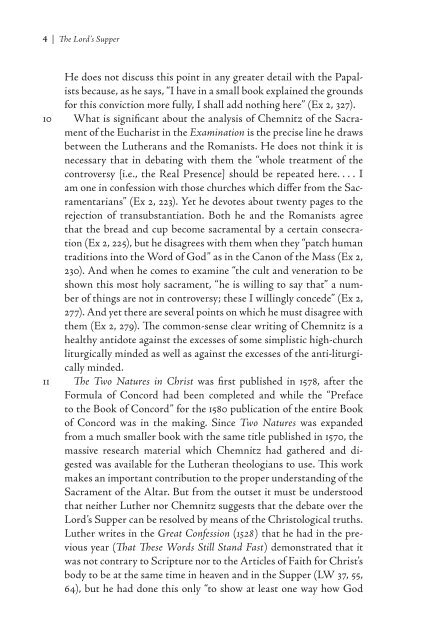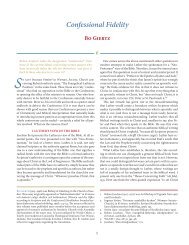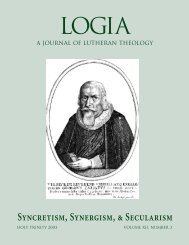The Lord's Supper in the Theology of Martin Chemnitz Bjarne - Logia
The Lord's Supper in the Theology of Martin Chemnitz Bjarne - Logia
The Lord's Supper in the Theology of Martin Chemnitz Bjarne - Logia
Create successful ePaper yourself
Turn your PDF publications into a flip-book with our unique Google optimized e-Paper software.
| <strong>The</strong> Lord’s <strong>Supper</strong><br />
He does not discuss this po<strong>in</strong>t <strong>in</strong> any greater detail with <strong>the</strong> Papalists<br />
because, as he says, “I have <strong>in</strong> a small book expla<strong>in</strong>ed <strong>the</strong> grounds<br />
for this conviction more fully, I shall add noth<strong>in</strong>g here” (Ex 2, 327).<br />
10 What is significant about <strong>the</strong> analysis <strong>of</strong> <strong>Chemnitz</strong> <strong>of</strong> <strong>the</strong> Sacrament<br />
<strong>of</strong> <strong>the</strong> Eucharist <strong>in</strong> <strong>the</strong> Exam<strong>in</strong>ation is <strong>the</strong> precise l<strong>in</strong>e he draws<br />
between <strong>the</strong> Lu<strong>the</strong>rans and <strong>the</strong> Romanists. He does not th<strong>in</strong>k it is<br />
necessary that <strong>in</strong> debat<strong>in</strong>g with <strong>the</strong>m <strong>the</strong> “whole treatment <strong>of</strong> <strong>the</strong><br />
controversy [i.e., <strong>the</strong> Real Presence] should be repeated here. . . . I<br />
am one <strong>in</strong> confession with those churches which differ from <strong>the</strong> Sacramentarians”<br />
(Ex 2, 223). Yet he devotes about twenty pages to <strong>the</strong><br />
rejection <strong>of</strong> transubstantiation. Both he and <strong>the</strong> Romanists agree<br />
that <strong>the</strong> bread and cup become sacramental by a certa<strong>in</strong> consecration<br />
(Ex 2, 225), but he disagrees with <strong>the</strong>m when <strong>the</strong>y “patch human<br />
traditions <strong>in</strong>to <strong>the</strong> Word <strong>of</strong> God” as <strong>in</strong> <strong>the</strong> Canon <strong>of</strong> <strong>the</strong> Mass (Ex 2,<br />
230). And when he comes to exam<strong>in</strong>e “<strong>the</strong> cult and veneration to be<br />
shown this most holy sacrament, “he is will<strong>in</strong>g to say that” a number<br />
<strong>of</strong> th<strong>in</strong>gs are not <strong>in</strong> controversy; <strong>the</strong>se I will<strong>in</strong>gly concede” (Ex 2,<br />
277). And yet <strong>the</strong>re are several po<strong>in</strong>ts on which he must disagree with<br />
<strong>the</strong>m (Ex 2, 279). <strong>The</strong> common-sense clear writ<strong>in</strong>g <strong>of</strong> <strong>Chemnitz</strong> is a<br />
healthy antidote aga<strong>in</strong>st <strong>the</strong> excesses <strong>of</strong> some simplistic high-church<br />
liturgically m<strong>in</strong>ded as well as aga<strong>in</strong>st <strong>the</strong> excesses <strong>of</strong> <strong>the</strong> anti-liturgically<br />
m<strong>in</strong>ded.<br />
11 <strong>The</strong> Two Natures <strong>in</strong> Christ was first published <strong>in</strong> 1578, after <strong>the</strong><br />
Formula <strong>of</strong> Concord had been completed and while <strong>the</strong> “Preface<br />
to <strong>the</strong> Book <strong>of</strong> Concord” for <strong>the</strong> 1580 publication <strong>of</strong> <strong>the</strong> entire Book<br />
<strong>of</strong> Concord was <strong>in</strong> <strong>the</strong> mak<strong>in</strong>g. S<strong>in</strong>ce Two Natures was expanded<br />
from a much smaller book with <strong>the</strong> same title published <strong>in</strong> 1570, <strong>the</strong><br />
massive research material which <strong>Chemnitz</strong> had ga<strong>the</strong>red and digested<br />
was available for <strong>the</strong> Lu<strong>the</strong>ran <strong>the</strong>ologians to use. This work<br />
makes an important contribution to <strong>the</strong> proper understand<strong>in</strong>g <strong>of</strong> <strong>the</strong><br />
Sacrament <strong>of</strong> <strong>the</strong> Altar. But from <strong>the</strong> outset it must be understood<br />
that nei<strong>the</strong>r Lu<strong>the</strong>r nor <strong>Chemnitz</strong> suggests that <strong>the</strong> debate over <strong>the</strong><br />
Lord’s <strong>Supper</strong> can be resolved by means <strong>of</strong> <strong>the</strong> Christological truths.<br />
Lu<strong>the</strong>r writes <strong>in</strong> <strong>the</strong> Great Confession (1528 ) that he had <strong>in</strong> <strong>the</strong> previous<br />
year (That <strong>The</strong>se Words Still Stand Fast ) demonstrated that it<br />
was not contrary to Scripture nor to <strong>the</strong> Articles <strong>of</strong> Faith for Christ’s<br />
body to be at <strong>the</strong> same time <strong>in</strong> heaven and <strong>in</strong> <strong>the</strong> <strong>Supper</strong> (LW 37, 55,<br />
64), but he had done this only “to show at least one way how God




